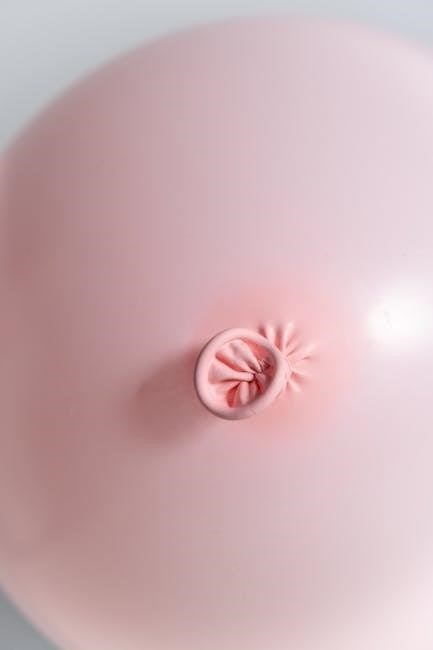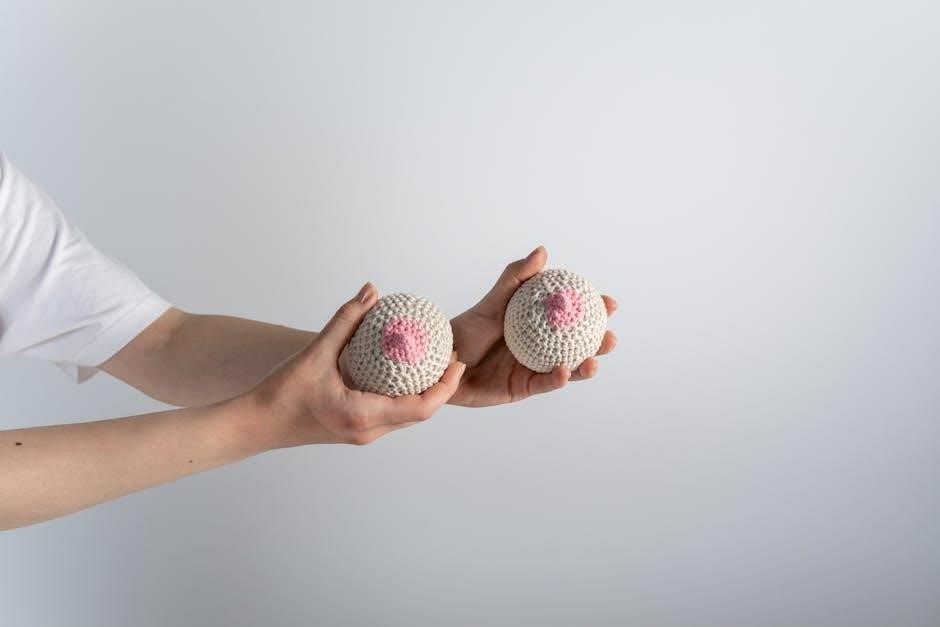
Medela nipple shields are designed to support breastfeeding by providing comfort and effectiveness. Proper sizing is essential for optimal fit and addressing common breastfeeding challenges, ensuring a better experience for mothers.
Why Proper Sizing is Crucial for Comfort and Effectiveness
Proper sizing of Medela nipple shields ensures optimal comfort and effectiveness during breastfeeding. Incorrect sizing can lead to soreness, mastitis, or poor latch, which may hinder milk flow and cause discomfort. A well-fitted shield supports proper nipple placement, reducing the risk of these issues. Correct sizing also prevents excessive pressure or pinching, which can disrupt breastfeeding sessions. Ensuring the right fit is essential for maintaining comfort and promoting effective breastfeeding. Proper sizing balances tightness and flexibility, allowing for a natural feeding experience while addressing challenges like nipple soreness or difficulty latching. This ensures both mother and baby benefit from a comfortable and efficient breastfeeding process.

Understanding Medela’s Sizing System
Medela’s sizing system offers various shield sizes to ensure a correct fit. The system is designed around nipple diameter measurements, providing a clear guide for mothers.
Available Sizes and Their Specifications
Medela offers a range of sizes for nipple shields, ensuring a proper fit for various nipple diameters. The PersonalFit breast shields are available in 21 mm, 24 mm, 27 mm, 30 mm, and 36 mm, while the PersonalFit Flex comes in 21 mm, 24 mm, 27 mm, and 30 mm. Additionally, the Contact Nipple Shields are available in Small (16 mm), Medium (20 mm), and Large (24 mm). Each size is designed to accommodate different nipple sizes comfortably, ensuring optimal fit and comfort during breastfeeding. The sizes are determined based on the diameter of the nipple, allowing for a snug yet non-restrictive fit. Proper sizing is crucial for effective breastfeeding and to prevent discomfort or complications. Medela’s range ensures that mothers can find a shield that meets their specific needs, promoting a positive breastfeeding experience.
How to Measure Your Nipple Diameter Accurately
To measure your nipple diameter accurately, place a ruler or measuring tape across the widest part of your nipple. Ensure the measurement is taken in millimeters (mm). For example, if your nipple measures 16 mm in diameter, the recommended Medela breast shield size is 21 mm. Always round up to the next size if your measurement falls between sizes. Accurate measurement is crucial to ensure a proper fit and prevent discomfort or issues like soreness or mastitis. Use this method to determine your size before selecting a Medela nipple shield, ensuring optimal comfort and effectiveness during breastfeeding. Proper measurement is the first step toward a successful and comfortable breastfeeding journey with Medela products.

How to Choose the Right Size for Your Needs
Measure your nipple diameter accurately, add 4mm to determine your Medela size, ensuring a comfortable and effective fit for optimal breastfeeding support and milk expression.
A Step-by-Step Guide to Determining Your Optimal Fit
To determine your optimal fit, start by measuring your nipple diameter using a ruler or measuring tape. Add 4mm to this measurement to find your recommended Medela size. For example, a 16mm nipple diameter suggests a 21mm shield. Ensure the shield fits comfortably without pinching or forcing. The edge should align closely with the widest part of your nipple. Test the fit by gently placing the shield, ensuring proper latch and milk flow. If discomfort or issues arise, adjust the size accordingly. Proper fit ensures effective breastfeeding and prevents complications like soreness or mastitis. Always prioritize comfort and functionality for a successful breastfeeding journey.

Signs of a Correct vs. Incorrect Fit
A correct fit is comfortable, with no pinching or nipple blanching, allowing proper latch and milk flow. Incorrect fit causes soreness, mastitis, or poor latch, requiring adjustment.
Identifying Proper Fit and Addressing Common Issues
A proper fit ensures comfort and effectiveness, with the nipple shield fitting snugly without pinching or causing discomfort. Look for even suction and milk flow during use. If the shield feels too tight or causes nipple blanching, it may be too small. Conversely, if it slips off easily or doesn’t create a proper seal, it may be too large. Common issues like soreness or mastitis can arise from incorrect sizing. To address this, ensure the shield is centered and gently secured. If discomfort persists, consider re-measuring your nipple diameter or consulting a lactation professional. Proper fit is key to preventing issues and promoting a successful breastfeeding experience.
- Check for even suction and milk flow.
- Ensure the shield is centered and snug without pinching.
- Address issues promptly to avoid complications.

Troubleshooting Common Fitting Issues
Common issues include soreness, mastitis, and poor latch. Ensure the shield fits snugly without pinching and re-measure if discomfort persists. Address fit problems promptly for optimal comfort.
- Check for proper fit and adjust as needed.
- Re-measure nipple diameter for accurate sizing.
- Consult a lactation professional if issues persist.
Solving Problems Like Soreness, Mastitis, and Poor Latch
Addressing common issues like soreness, mastitis, and poor latch is crucial for a successful breastfeeding journey. Ensure the nipple shield fits properly, as an ill-fitting shield can cause discomfort and lead to complications. If soreness occurs, check the sizing and adjust as needed. Mastitis, often caused by improper fit or poor milk expression, may require medical attention. For poor latch, ensure the shield is centered and gently guides the baby’s mouth to the nipple. Regularly re-measure your nipple diameter to confirm the correct size. If issues persist, consult a lactation professional for personalized guidance. Proper fit and care can prevent these challenges, ensuring a comfortable and effective breastfeeding experience.
- Ensure proper fit to avoid soreness and mastitis.
- Adjust the shield for a comfortable and effective latch.
- Consult a professional if issues persist.

Maintaining Proper Hygiene and Care
Regularly wash Medela nipple shields with mild soap and warm water, then sterilize and air-dry to ensure hygiene. Proper storage extends their lifespan and effectiveness.
Cleaning and Storing Your Medela Nipple Shields
Proper cleaning and storage are crucial for maintaining the hygiene and longevity of Medela nipple shields. Begin by rinsing them with warm water to remove any milk residue. Use a mild soap and gently scrub with your fingers or a soft brush, ensuring all areas are clean. After washing, rinse thoroughly and sterilize using a breast pump sterilizing bag or a pot of boiling water for 10 minutes. Allow the shields to air-dry on a clean towel. Store them in a dry, clean container or the provided case to prevent contamination. Regular cleaning prevents bacterial growth and ensures safe usage for breastfeeding. Always check for signs of wear and replace as needed to maintain effectiveness and comfort. Proper care extends the life of your Medela nipple shields and supports a healthy breastfeeding journey.


Maximizing Your Breastfeeding Experience

Optimizing posture and ensuring a proper latch are key to maximizing breastfeeding comfort and efficiency with Medela nipple shields. Correct positioning enhances milk flow and reduces discomfort, fostering a positive experience for both mother and baby.
Optimizing Posture and Pumping Efficiency
Proper posture plays a crucial role in maximizing breastfeeding and pumping efficiency. When using Medela nipple shields, ensure your back is straight and shoulders relaxed to prevent strain. Position your baby at breast height to encourage a natural latch and effective milk flow. During pumping, maintain a slight lean forward, keeping the breast shield centered and comfortable. Correct positioning prevents nipple soreness and ensures optimal expression; Additionally, using the correct Medela nipple shield size, as determined by your nipple diameter, further enhances comfort and efficiency. By combining proper posture with the right fit, you can create a seamless and productive breastfeeding experience for both you and your baby.

Additional Tips for a Successful Breastfeeding Journey
Stay hydrated, maintain a balanced diet, and practice skin-to-skin contact to enhance milk production and bonding. Regularly assess your nipple shield fit and seek professional guidance if needed.
When to Consult a Lactation Professional
Consult a lactation professional if you experience persistent discomfort, soreness, or difficulty latching, despite proper sizing. They can assess fit, address issues like mastitis, and provide personalized guidance to optimize your breastfeeding experience. Professionals can also help troubleshoot challenges such as poor latch or unexpressed milk, ensuring both comfort and efficiency. Regular check-ins can prevent complications and support long-term breastfeeding success, especially when using tools like Medela nipple shields. Their expertise is invaluable for resolving complex fitting issues and promoting a positive journey for mothers and babies.